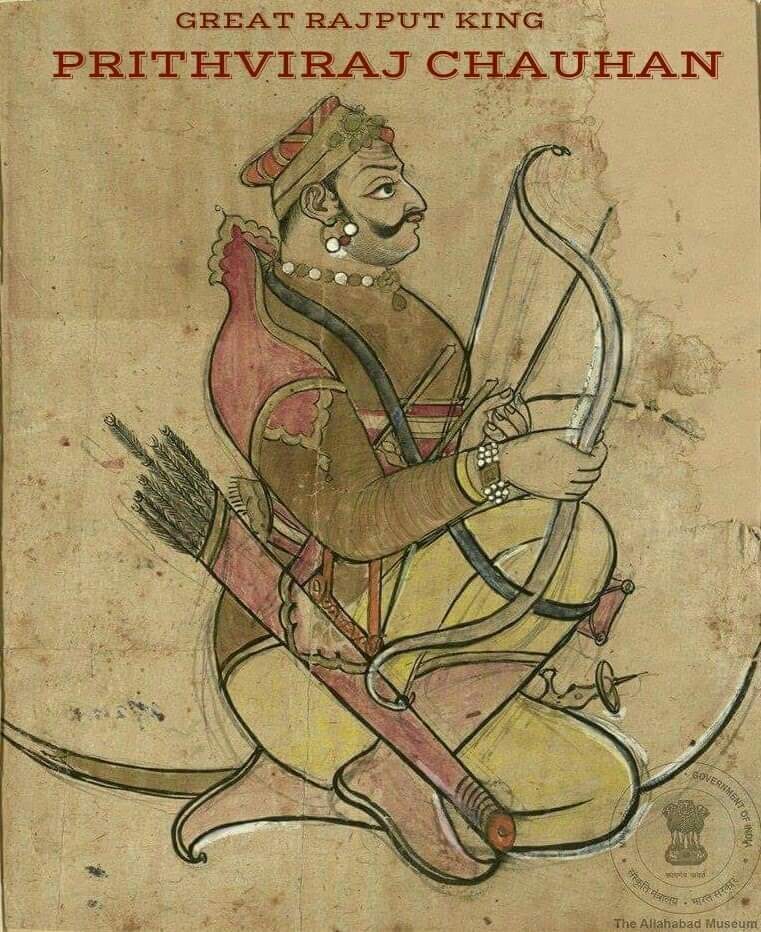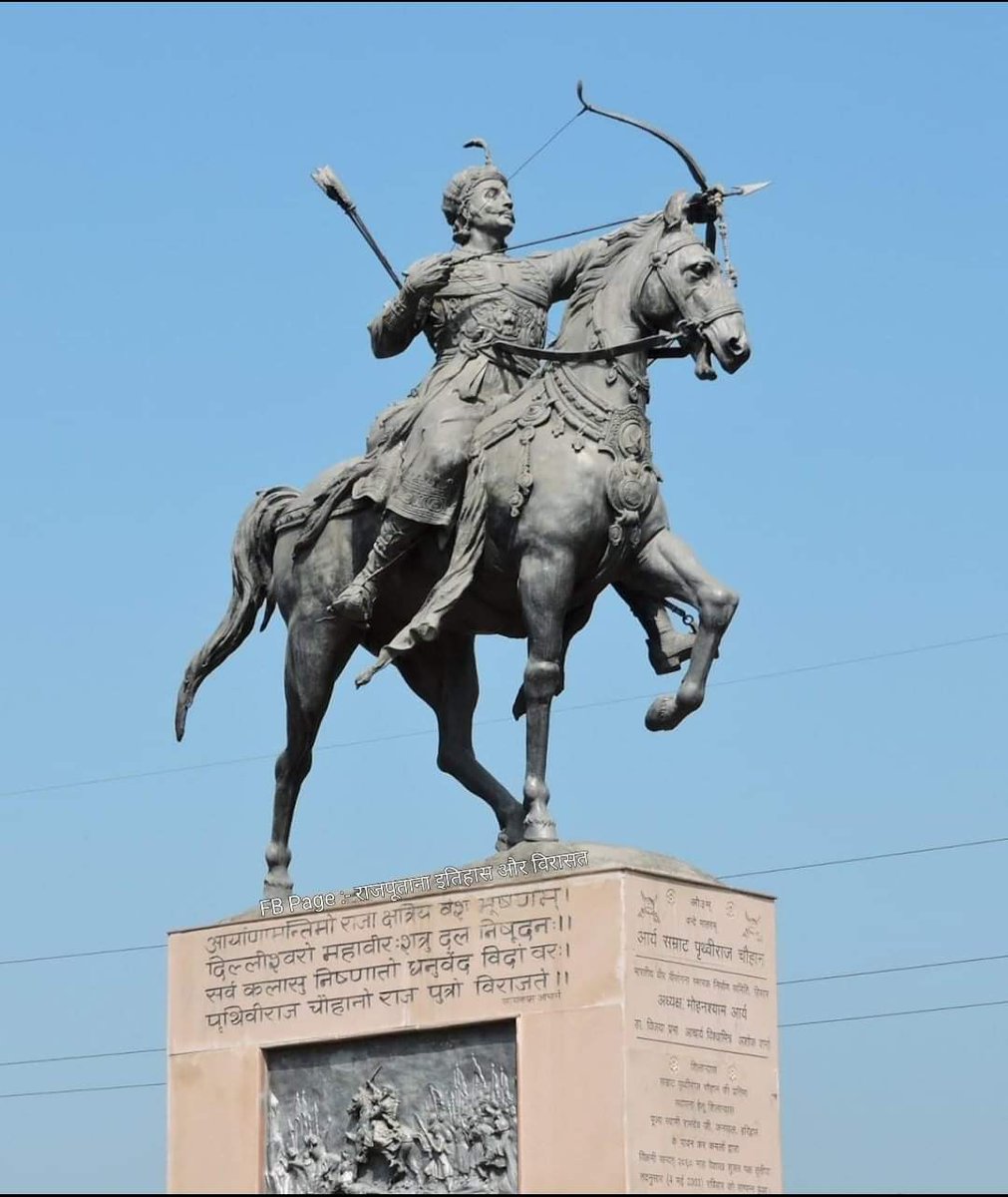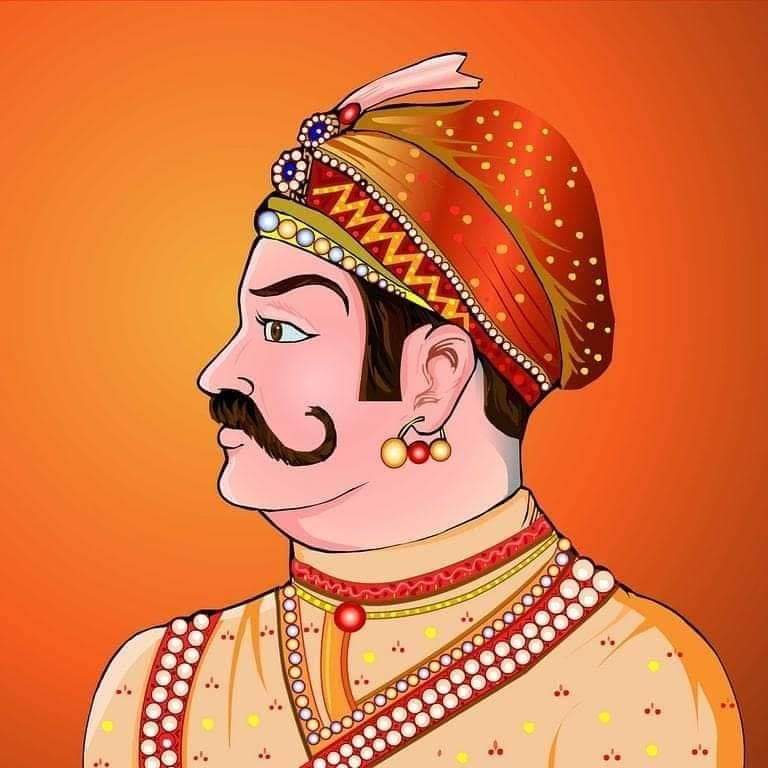Battle of Tarain - Estimate of Forces on Both Sides in the Two Battles
Let’s look at the condition of the Chauhan kingdom and their forces after second battle. South Punjab was a new acquisition that they had made by defeating Ghaznavid sultanate;
#rajputsamratprithvirajchauhan
Let’s look at the condition of the Chauhan kingdom and their forces after second battle. South Punjab was a new acquisition that they had made by defeating Ghaznavid sultanate;
#rajputsamratprithvirajchauhan
hence this area was lost very quickly. However, their main base was in Rajasthan which continued to hold out under the leadership of the Chauhans of Ranthambhor for another century. Mohammed Ghori’s major blunder was in moving on
#rajputsamratprithvirajchauhan
#rajputsamratprithvirajchauhan
towards the Gangetic plains and not completing the conquest of the Kingdom of Ajmer.
#rajputsamratprithvirajchauhan
#rajputsamratprithvirajchauhan
◆ Generals of Prithviraj Chauhan ◆
★ Chauhans of Ranthambhor: The founder of this kingdom named Govindraj was banished from Ajmer for some offense and was therefore not present in either of two battles. Since his kingdom became a major thorn in
#rajputsamratprithvirajchauhan
★ Chauhans of Ranthambhor: The founder of this kingdom named Govindraj was banished from Ajmer for some offense and was therefore not present in either of two battles. Since his kingdom became a major thorn in
#rajputsamratprithvirajchauhan
the side of the Delhi Sultanate it is assumed that he had a substantial army.
★ Govindraj of Delhi: He and his son Chandraraj held Delhi. In the first battle, he was mounted on an elephant and had his teeth knocked out by a spear.
#rajputsamratprithvirajchauhan
★ Govindraj of Delhi: He and his son Chandraraj held Delhi. In the first battle, he was mounted on an elephant and had his teeth knocked out by a spear.
#rajputsamratprithvirajchauhan
Govindraj immediately hurled back a lance at Ghori, which caused such bleeding that the sultan fainted on his horse, and was carried off to safety by a Khalji soldier along with rest of the fleeing Turk cavalry. Govindraj was killed in second battle
#rajputsamratprithvirajchauhan
#rajputsamratprithvirajchauhan
while his son Chandraraj defended the fort of Delhi.
★ Bhuvanik Malla: According to the contemporary Hindu text Pṛthvīrāja Vijaya, the brothers Prithviraj and Hariraj were like Bhagavān Rama & Bhagavān Lakshman, while the general Bhuvanik Malla
#rajputsamratprithvirajchauhan
★ Bhuvanik Malla: According to the contemporary Hindu text Pṛthvīrāja Vijaya, the brothers Prithviraj and Hariraj were like Bhagavān Rama & Bhagavān Lakshman, while the general Bhuvanik Malla
#rajputsamratprithvirajchauhan
was the incarnation of Garuda (who saved the princes of Ayodhya from the serpent noose of Meghnad). This general defeated the Bharasiva Nagas of Central India, but his presence at either of the two Tarain battles is not known.
#rajputsamratprithvirajchauhan
#rajputsamratprithvirajchauhan
★ Skanda: descendants of this general wrote Viruddhavidhi-vidhvamsa in which they assert that he fought at 1st battle of Tarain but was absent in another campaign during 2nd battle. After death of Prithviraj he helped Hariraja in capturing Ajmer.
#rajputsamratprithvirajchauhan
#rajputsamratprithvirajchauhan
★ Udayaraj: This general was from Gauda (Bengal) according to the Pṛthvīrāja Vijaya. Another text, Hammir-Mahakavya which was written more than a century later, confirms his existence and asserts that he attacked the city of Delhi in an attempt
#rajputsamratprithvirajchauhan
#rajputsamratprithvirajchauhan
to rescue the captive Prithviraj. He was absent at the second Battle of Tarain because he could not muster his troops in time to join Prithviraj.
#rajputsamratprithvirajchauhan
#rajputsamratprithvirajchauhan
★ Hariraja the brother of Prithviraj Chauhan : He liberated Ajmer and launched an attack on Delhi. He had friendly relations with the Solanki Rajputs of Gujarat, but was finally defeated by the Turks in 1194, and killed himself to avoid captivity.
#rajputsamratprithvirajchauhan
#rajputsamratprithvirajchauhan
Hariraja’s rule is confirmed by archaeological evidence in the shape of his inscription dated 1194, and those texts which record his name have a greater value than others.
#rajputsamratprithvirajchauhan
#rajputsamratprithvirajchauhan
So we have these twin pieces of evidence to show that Prithviraj had a much smaller army in the Second Battle of Tarain:
1. The absence of his generals Skanda, Udayaraja, and Bhuvanik Malla. Each general had the power to lead separate campaigns and
#rajputsamratprithvirajchauhan
1. The absence of his generals Skanda, Udayaraja, and Bhuvanik Malla. Each general had the power to lead separate campaigns and
#rajputsamratprithvirajchauhan
must have commanded substantial forces.
2. The ability of the Chauhans of Ranthambhor to defy the Delhi Sultanate for a full century, the ability of the surviving Chauhan generals to counter-attack the Turks in Delhi, and the ability of Hariraja
#rajputsamratprithvirajchauhan
2. The ability of the Chauhans of Ranthambhor to defy the Delhi Sultanate for a full century, the ability of the surviving Chauhan generals to counter-attack the Turks in Delhi, and the ability of Hariraja
#rajputsamratprithvirajchauhan
to liberate Ajmer, all suggest that a large part of the Chauhan force was not present at Tarain.
The conventional method in calculating the cavalry forces in the medieval era, when cavalry was the dominant element of most armies, is to assign
#rajputsamratprithvirajchauhan
The conventional method in calculating the cavalry forces in the medieval era, when cavalry was the dominant element of most armies, is to assign
#rajputsamratprithvirajchauhan
10,000 horsemen to any prince or general named prominently in the records. However in India cavalry-dominant armies only emerged in the 14th century with Mewar, Marwar, and Vijayanagar, and for the forces of Prithviraj Chauhan the contemporary texts
#rajputsamratprithvirajchauhan
#rajputsamratprithvirajchauhan
describe a mixed formation of horse cavalry and infantry, sprinkled with some elephants and camels. Infantry was in greater numbers to cavalry, which in turn outnumbered camels, which were more than elephants imported from more fertile regions
#rajputsamratprithvirajchauhan
#rajputsamratprithvirajchauhan
(In eastern and southern India the proportions were: infantry>>elephants>>cavalry the last of which was imported). For the Turks, who controlled the horse breeding region of Central Asia and West Asia proportions were cavalry>>>camels>>>>infantry>>>
#rajputsamratprithvirajchauhan
#rajputsamratprithvirajchauhan
elephants (imported from India).
◆ Estimate of forces in the Second Battle of Tarain - 1192 ◆
The Muslim sources only state cavalry forces and barely mention the others, and in the Second Battle of Tarain they state that Ghori divided his army
#rajputsamratprithvirajchauhan
◆ Estimate of forces in the Second Battle of Tarain - 1192 ◆
The Muslim sources only state cavalry forces and barely mention the others, and in the Second Battle of Tarain they state that Ghori divided his army
#rajputsamratprithvirajchauhan
into four units of 10,000 horse keeping fifth of 12,000 under his own command, giving a total of 52,000 cavalry with the camels, infantry, and elephant numbers unknown for Muhammad Ghori’s army. For Chauhan army, the only general named is Govindraj
#rajputsamratprithvirajchauhan
#rajputsamratprithvirajchauhan
of Delhi and Prithviraj himself, and both Hindu and Muslim accounts state that Prithviraj tried to buy time by negotiating so that at least Udayaraj would come up in time to bolster his army. But assuming that there were other minor chieftains
#rajputsamratprithvirajchauhan
#rajputsamratprithvirajchauhan
commanding units of a few thousand, with at least 10,000 under Govindraj, and assuming 12,000 under Prithviraj, we can conclude that the Chauhan army numbered 30,000 at the most, with the all-important cavalry at only 10,000.
#rajputsamratprithvirajchauhan
#rajputsamratprithvirajchauhan
This explains the total rout of this army by the five times larger Turk cavalry.
◆ Estimate of forces in the First Battle of Tarain - 1191 ◆
In the First Battle of Tarain, both Udayaraj and Skanda were present, boosting the total Rajput army to
#rajputsamratprithvirajchauhan
◆ Estimate of forces in the First Battle of Tarain - 1191 ◆
In the First Battle of Tarain, both Udayaraj and Skanda were present, boosting the total Rajput army to
#rajputsamratprithvirajchauhan
50,000 with the cavalry at 20,000. Muhammad Ghori who had spent some of his army to garrison the fort of Sarhind, is stated by the Muslim sources to have kept his army in the conventional three wings, commanding the center himself.
#rajputsamratprithvirajchauhan
#rajputsamratprithvirajchauhan
The Muslim army can be estimated at 35,000 cavalry (+ camels, infantry, elephants numbers unknown) with 10,000 in either wing and a few thousand rearguards. The Rajput army placed the cavalry in the wings and kept infantry & elephants in the center.
#rajputsamratprithvirajchauhan
#rajputsamratprithvirajchauhan
Although the wings were evenly matched, the Turks hesitated and the Rajputs struck the first blow, the momentum of their charge breaking up Ghori’s wings which eventually gave way in the ensuing swordfight at close quarters. Meanwhile, Ghori was
#rajputsamratprithvirajchauhan
#rajputsamratprithvirajchauhan
holding on in the center as the elephants and infantry of the Rajput center slowly came up to join the battle, and as described above Govindraj mounted on his elephant, seriously wounded Ghori, sending him flying with the rest of the center.
#rajputsamratprithvirajchauhan
#rajputsamratprithvirajchauhan
After the victory the Hindu army gave chase but was easily outpaced by the Turk cavalry; hence they besieged Sarhind and forced its surrender after nearly 12 months.
The Wikipedia entry on the Battles of Tarain makes some startling claims:
#rajputsamratprithvirajchauhan
The Wikipedia entry on the Battles of Tarain makes some startling claims:
#rajputsamratprithvirajchauhan
Many Turk soldiers in Ghauri’s army had not even seen elephants before
Elephants were being used in warfare in the wider world since the time of the ancient Greeks and Romans. A previous Turk invader, Mahmud Ghaznavi, captured elephants in India
#rajputsamratprithvirajchauhan
Elephants were being used in warfare in the wider world since the time of the ancient Greeks and Romans. A previous Turk invader, Mahmud Ghaznavi, captured elephants in India
#rajputsamratprithvirajchauhan
and they formed part of Muslim armies since then.
Ghauri’s horse cavalry was unable to hold its own against Prithviraj’s elephant cavalry.
There was no elephant cavalry! Prithviraj’s kingdom covered the dry regions of Rajasthan, Haryana, and
#rajputsamratprithvirajchauhan
Ghauri’s horse cavalry was unable to hold its own against Prithviraj’s elephant cavalry.
There was no elephant cavalry! Prithviraj’s kingdom covered the dry regions of Rajasthan, Haryana, and
#rajputsamratprithvirajchauhan
southern Punjab, and elephants had to be imported from eastern or central India which were more densely forested. Only the leading generals sat on elephants in the center, with other elephants and infantry, while cavalry made up the wings.
#rajputsamratprithvirajchauhan
#rajputsamratprithvirajchauhan
It was the Rajput horse cavalry from the two wings that routed the Muslim cavalry opposite them.
As the battle continued, the Ghauri army, exhausted, shorn of water, and unfamiliar with the scale of its opponent, retreated
Patently false, as even
#rajputsamratprithvirajchauhan
As the battle continued, the Ghauri army, exhausted, shorn of water, and unfamiliar with the scale of its opponent, retreated
Patently false, as even
#rajputsamratprithvirajchauhan
the Muslim accounts admit that the two wings were routed by the Rajputs, broke down, and fled. While the center also fled after the sultan was wounded and fainted on his horse.
Ghauri was himself wounded in the battle and was rescued by his Turkic
#rajputsamratprithvirajchauhan
Ghauri was himself wounded in the battle and was rescued by his Turkic
#rajputsamratprithvirajchauhan
slave, Qutb-ud-din Aibak
He was actually rescued by a Khalji trooper and not Aibak, who was a prominent general and would have commanded in one of the wings.
ruler of Kannauj Jaichand who met Ghori & divulged secrets of Chauhan’s planning of war.
#rajputsamratprithvirajchauhan
He was actually rescued by a Khalji trooper and not Aibak, who was a prominent general and would have commanded in one of the wings.
ruler of Kannauj Jaichand who met Ghori & divulged secrets of Chauhan’s planning of war.
#rajputsamratprithvirajchauhan
The kingdoms of Ajmer and Kannauj did not have a common border, fought no battles.
As per inscriptions, Jayachandra was fighting against the Sena rulers in the region of Bihar, far in the east.
#rajputsamratprithvirajchauhan
As per inscriptions, Jayachandra was fighting against the Sena rulers in the region of Bihar, far in the east.
#rajputsamratprithvirajchauhan

 Read on Twitter
Read on Twitter




